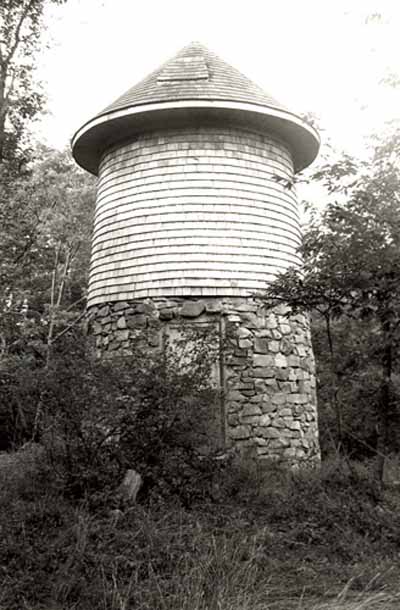Water Tower
Recognized Federal Heritage Building
St. Lawrence Islands National Park of Canada, Ontario

Exterior view
(© Parks Canada Agency / Agence Parcs Canada / Historica Resources Ltd., 1992.)
Address :
Batterman's Point, Hill Island, St. Lawrence Islands National Park of Canada, Ontario
Recognition Statute:
Treasury Board Policy on Management of Real Property
Designation Date:
1995-02-06
Dates:
-
1920 to 1920
(Construction)
Other Name(s):
-
Batterman's Point Water Tower (Hill Island)
(Other Name)
Custodian:
Parks Canada
FHBRO Report Reference:
93-030
DFRP Number:
09431 00
Description of Historic Place
The Water Tower is located on a ridge at Batterman’s Point on Hill Island in the St. Lawrence Islands National Park of Canada. The small cylindrical tower has a rubble stone base with cedar shingle cladding above and a conical roof, also covered in cedar shingles. There is a door in the side of the tower and a small window directly opposite this. The designation is confined to the footprint of the building.
Heritage Value
The Water Tower is a Recognized Federal Heritage Building because of its historical associations, and its architectural and environmental values.
Historical Value
The Water Tower, due to its function as an outbuilding for a grand 19th-century cottage property in the Thousand Islands area, is associated with the cottage movement in Canada. Set within one of North America’s most prestigious cottage regions, the Water Tower is associated with Grant Mitchell, Chairman of the Thousand Islands Bridge Authority, who owned Batterman’s Point from 1964 to 1982. As one of four extant structures dating from the early 20th century on the property, the Water Tower is a visible reminder of Batterman’s Point’s grand past.
Architectural Value
The Water Tower is valued for its very good aesthetics and functional design. It is an interesting example of the application of Rustic style architectural motifs to a highly functional structure. It incorporates local materials, Tudor Revival elements and whimsical detailing to achieve a highly pleasing and picturesque design. The decision to apply decorative elements to this utilitarian structure demonstrates the owner’s wealth and commitment to the Rustic style and picturesque aesthetic that dominated cottage design throughout the 20th century. Very good craftsmanship is evidenced in the woodwork and masonry.
Environmental Value
The Water Tower is compatible with the picturesque character of Batterman’s Point.
Sources: Kate MacFarlane, Twenty Eight Buildings, St. Lawrence Islands National Park, Ontario, Federal Heritage Buildings Review Office, Reports 93-023 through 93-038; Water Tower, Batterman’s Point, Hill Island, St. Lawrence Islands National Park, Ontario, Heritage Character Statement 93-030.
Character-Defining Elements
The following character-defining elements of the Water Tower should be respected.
Its very good aesthetics, very good functional design and quality craftsmanship, for example: its picturesque quality as expressed through its small scale, Rustic style design, application of decorative elements, and use of local materials; its tapered cylindrical shape, low-pitched conical roof, cedar-shingle cladding and rubble-stone base; the composition and arrangement of the door and small window.
The manner in which it reinforces the picturesque character of the setting as evidenced in: its remote location on a high elevation and heavily treed site, overlooking the St. Lawrence River.
Heritage Character Statement
Disclaimer -
The heritage character statement was developed by FHBRO to explain the reasons for the designation of a federal heritage building and what it is about the building that makes it significant (the heritage character). It is a key reference document for anyone involved in planning interventions to federal heritage buildings and is used by FHBRO in their review of interventions.
The Water Tower was constructed around 1920, one of four extant buildings at Batterman's Point built at that time as outbuildings for a large 19th-century summer home demolished in 1982. The designer of the Water Tower is unknown. The Water Tower was refurbished in the early 1990s with new cedar shingle siding and roof. Parks Canada is the custodian.
Reasons for Designation
The Water Tower has been designated 'Recognized' because of its historical and architectural significance:
Historical Significance
Due to its function as an outbuilding for a grand cottage property in the Thousand Islands area, the Water Tower is associated with the cottage movement in Canada and the area's distinction as one of North America's most prestigious cottage regions. The Water Tower was likely constructed around 1920 by a subsequent owner of the cottage property, Wallis Bird. As one of four extant structures dating from the early 20th century on the property, the Water Tower is a visible reminder of Batterman's Point's grand past.
Architectural Significance
The Water Tower is an interesting example of the application of Rustic architectural motifs to a highly functional structure. It incorporates local materials, Tudor Revival elements and whimsical detailing to achieve a highly pleasing and picturesque design. The decision to apply decorative elements to this utilitarian structure demonstrates the owner's wealth and the owner's commitment to the Rustic Picturesque aesthetic that dominated cottage design throughout the 20th century.
Character-Defining Elements
The heritage character of the Water Tower resides in the following character-defining elements:
-The picturesque quality of the Water Tower, as expressed through its tapered cylindrical shape, low-pitched conical roof, cedar-shingle cladding and rubble-stone base.
All maintenance and repair work, as well as future interventions, should respect these character-defining elements.